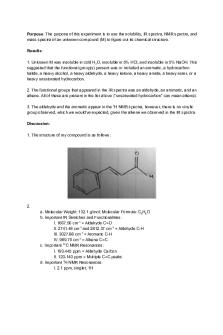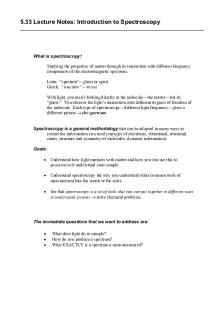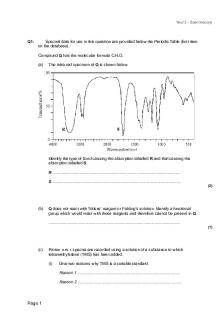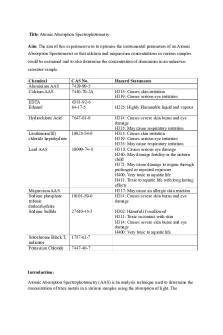Spectroscopy Lab PDF

| Title | Spectroscopy Lab |
|---|---|
| Course | Organic Chemistry 2 |
| Institution | University of Chicago |
| Pages | 2 |
| File Size | 107.9 KB |
| File Type | |
| Total Downloads | 36 |
| Total Views | 166 |
Summary
Spectroscopy Lab Report...
Description
Purpose: The purpose of this experiment is to use the solubility, IR spectra, NMR spectra, and mass spectra of an unknown compound (M) to figure out its chemical structure. Results: 1. Unknown M was insoluble in cold H2O, insoluble in 5% HCl, and insoluble in 5% NaOH. This suggested that the functional group(s) present was or included an aromatic, a hydrocarbon halide, a heavy alcohol, a heavy aldehyde, a heavy ketone, a heavy amide, a heavy ester, or a heavy unsaturated hydrocarbon. 2. The functional groups that appeared in the IR spectra was an aldehyde, an aromatic, and an alkene. All of these are present in the list above ("unsaturated hydrocarbon" can mean alkene). 3. The aldehyde and the aromatic appear in the 1 H NMR spectra, however, there is no vinylic group observed, which we would've expected, given the alkene we observed in the IR spectra. Discussion: 1. The structure of my compound is as follows:
2. a. Molecular Weight: 132.1 g/mol; Molecular Formula: C9H8O b. Important IR Stretches and Functionalities: I. 1667.56 cm-1 = Aldehyde C=O II. 2741.48 cm-1 and 2812.37 cm-1 = Aldehyde C-H -1 III. 3027.88 cm = Aromatic C-H IV. 969.70 cm-1 = Alkene C=C 13 c. Important C NMR Resonances: I. 193.445 ppm = Aldehyde Carbon II. 120-140 ppm = Multiple C=C peaks d. Important 1 H NMR Resonances: I. 2.1 ppm, singlet, 1H
II. 6.5 ppm, 6.7 ppm, 2 doublets, combined 2H III. 7.4 ppm, multiplet, 13H IV. 9.6 ppm, doublet, 2H 3. My compound, commonly known as "cinnamaldehyde," has published solubility data as follows: A) Insoluble in water. B) Miscible with alcohols. C) Miscible with Ethers. D) Miscible with Chloroform. Per PubChem Database for Cinnamaldehyde... All of the following agree with what was observed in lab, including solubility in chloroform (which we did for the 1 H NMR Spectrum). We also observed it was insoluble in HCl, insoluble in NaOH, soluble in benzene, soluble in dichloromethane, and soluble in EtOAc. All of the following agree with the structure we derived for the molecule. 4. The most useful resources for figuring out this unknown compound were the mass spectrometry data, the IR data (for functional groups), and the 1 H NMR data (for non equivalent hydrogens and overall shape). Once it was discovered that there was an aromatic benzyl, an aldehyde, and an alkene, it was very easy to put together the structure knowing the molar mass of 132.1 g/mol. The 13 C NMR and the solubilities were important in confirming our predicted molecule, but not as much in figuring out the molecule's functional groups and shape. Lastly, one other aspect was very crucial in figuring out cinnamaldehyde as the unknown. It is uncommon (for the chemicals we've used in lab thus far) that there is a colored compound that doesn't have a halogen. Thus, the yellow-green color of cinnamaldehyde was very critical in confirming our findings. This confirmation was made via the PubChem database, which describes cinnamaldehyde as a "greenish yellow liquid" and "yellow oil." Sources (Excluding Solomons Organic Chemistry) IR-Frequencies, www2.ups.edu/faculty/hanson/Spectroscopy/IR/IRfrequencies.html. “Cinnamaldehyde.” National Center for Biotechnology Information. PubChem Compound Database , U.S. National Library of Medicine, pubchem.ncbi.nlm.nih.gov/compound/cinnamaldehyde#section=Physical-Description. “IR Spectrum Table & Chart.” H2NC6H4CO2C2H5 , Drugs, www.sigmaaldrich.com/technical-documents/articles/biology/ir-spectrum-table.html....
Similar Free PDFs

Spectroscopy Lab
- 2 Pages

Chem 2101 - Spectroscopy lab
- 2 Pages

Chem 101 Spectroscopy Lab
- 7 Pages

Spectroscopy
- 5 Pages

Mass Spectroscopy
- 14 Pages

Raman Spectroscopy
- 22 Pages

Spectroscopy Questions
- 116 Pages

Infrared Spectroscopy
- 3 Pages

Spectroscopy+EC 0002a
- 1 Pages

Introduction to Spectroscopy 1
- 3 Pages

Atomic Absorption Spectroscopy
- 271 Pages
Popular Institutions
- Tinajero National High School - Annex
- Politeknik Caltex Riau
- Yokohama City University
- SGT University
- University of Al-Qadisiyah
- Divine Word College of Vigan
- Techniek College Rotterdam
- Universidade de Santiago
- Universiti Teknologi MARA Cawangan Johor Kampus Pasir Gudang
- Poltekkes Kemenkes Yogyakarta
- Baguio City National High School
- Colegio san marcos
- preparatoria uno
- Centro de Bachillerato Tecnológico Industrial y de Servicios No. 107
- Dalian Maritime University
- Quang Trung Secondary School
- Colegio Tecnológico en Informática
- Corporación Regional de Educación Superior
- Grupo CEDVA
- Dar Al Uloom University
- Centro de Estudios Preuniversitarios de la Universidad Nacional de Ingeniería
- 上智大学
- Aakash International School, Nuna Majara
- San Felipe Neri Catholic School
- Kang Chiao International School - New Taipei City
- Misamis Occidental National High School
- Institución Educativa Escuela Normal Juan Ladrilleros
- Kolehiyo ng Pantukan
- Batanes State College
- Instituto Continental
- Sekolah Menengah Kejuruan Kesehatan Kaltara (Tarakan)
- Colegio de La Inmaculada Concepcion - Cebu




